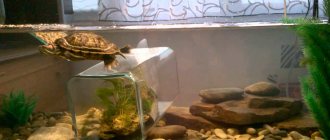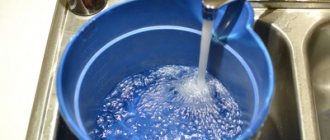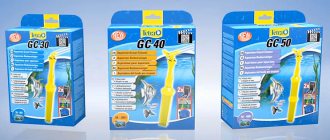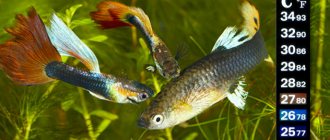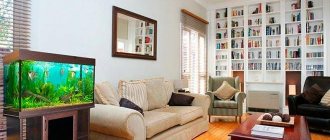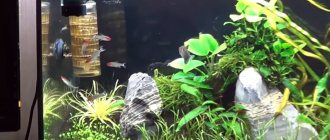In an aquarium, water is an important element, without which none of the aquarium fish can exist. But few beginning fish keepers know what it should be like and where to get water for an aquarium. If the liquid does not meet the requirements of the inhabitants of the tank, or contains hazardous substances, then the use of such water will disrupt the biobalance and cause the death of phenotypes. Recommendations and advice from experienced aquarists will help you find out what kind of water you can pour into the aquarium and how to properly prepare the liquid.
What water is suitable for an aquarium
Typically, tap water has neutral parameters. Depending on the needs of your pets, change the liquid parameters. Water for an aquarium with fish must be settled. You can find out the amount of impurities using tests sold in pet stores.
In spring, the liquid has unstable parameters and composition, so use conditioners. Cleaning from chlorine is mandatory at any time of the year. Monitor pH levels. Aeration and portioned addition of water to the aquarium are used to achieve optimal parameters at home.
Temperature
Different types have different temperature conditions. Water temperature affects the quality of aeration and fish spawning. By increasing the parameter to 28 degrees, the fish enter a breeding state.
The critical point is 35 degrees. At higher temperatures, the aquarium population dies. You should not allow the temperature to drop below 18 degrees; this is the minimum value for cold-loving fish. An aquarium heater is used to maintain the temperature.
Rigidity
Hardness - the content of calcium, magnesium and other alkaline earth metal salts.
It can be permanent (non-carbonate) and temporary (carbonate). Unit of measurement: degrees of hardness (dGH, dKH). This parameter is unstable: the population of the aquarium absorbs salts, and stones and shells increase hardness. Salinity also changes throughout the year. Hardness increases with evaporation and decreases during the rainy season.
Aquarium inhabitants of different species need different rigidity. An aquarium with snails and crayfish requires hard water to maintain the strength of the shell, while some fish are only suitable for soft water. Determine hardness using special tests.
Hardness table:
| Hardness dGH | Water |
| 0–4 | very soft |
| 4–8 | soft |
| 8–12 | medium hard |
| 12–18 | moderate hardness |
| 18–30 | tough |
Acidity
Acidity (pH) is the pH value of an acidic environment.
Acidity is affected by:
- temperature;
- Times of Day;
- rigidity.
In the morning, the acidity is higher, in the evening the indicator shifts towards alkaline water. Aeration makes the water more acidic. In hard water, changes occur smoothly. The pH level is determined by litmus paper or tests. A chemical reaction in an acidic environment will color the paper red, in an alkaline environment it will turn blue. You can make water alkaline using baking soda. Acidity increases with peat.
Partial replacement
Partial replacement of water in a closed aquarium system emulates natural conditions. In any body of water there is a natural circulation of water. Some of the moisture evaporates or is absorbed into the ground, and is replaced by water from springs and tributaries.
Nitrates, toxins and harmful substances accumulate in the aquarium, which appear during the life of its inhabitants, and the more there are, the more often it is worth replacing part of the water with new one.
Only ¼ of the total water needs to be replaced. In this case, the balance will be restored within a few days, and plants and the most sensitive inhabitants will not be harmed. You need to replace the water in a saltwater aquarium in the same way, but use special salt.
When replacing half the volume of liquid, many inhabitants of the aquarium may die; restoration of the ecosystem will take several weeks.
Water for fish
There is no ideal habitat for all fish; each species has its own preferences. Some people like it sour, others like it more alkaline. Unpretentious fish adapt to different ranges of hardness, acidity and other water parameters.
Fish survive under the following parameters:
- hardness 5–25 dGh;
- temperature 23–26 degrees;
- pH 6.5–8.
Ideal water parameters for fish:
| Kinds | Acidity pH | Hardness dGH | Temperature °C |
| Discus and angelfish | 5,5–6,5 | 1–4 | 25–31 |
| West African Cichlids | 6–7 | 5–12 | 23–28 |
| Some characins and carps | 6–8 | 5–12 | 23–26 |
| Labyrinthine | 6,5–7,5 | 5–10 | 23–28 |
| Viviparous | 7–8,5 | 15–25 | 18–28 |
| Central American Cichlids | 6,5–7,5 | 10–20 | 20–24 |
| Cichlids of Lake Malawi | 7,7–8,5 | 10–15 | 23–28 |
| Cichlids of Lake Tanganyika | 8–9,3 | 10–15 | 24–28 |
Some species of Killifish are adapted to survive at temperatures up to 45 degrees. Cichlids of the genus Telapia survive at 70 degrees. Fish in an aquarium need moderately hard water. Neons and some types of bettas and barbs require soft, cool water.
For pregnant females and fry
For a separate container with a pregnant female, use aquarium water that is familiar to the fish. Replenish the lack of liquid with settled liquid. When placing a fish in an aquarium, make sure that the temperature and water parameters are comfortable for the expectant mother.
Change the fluid more often and siphon the soil. At temperatures above 28 degrees, viviparous fish experience premature birth. However, this property is useful if the fish cannot give birth.
What funds will be needed?
In order for the water to meet the necessary parameters suitable for the life of fish, various quality-improving agents are added to it:
- baking soda - to reduce acidity levels;
- peat, wood (except oak and species with a high resin content) - to increase acidity;
- chalk, limestone - to increase rigidity;
- to reduce hardness:
boiling – add 2/3 of the cooled boiled water to the aquarium;- dilution with melt water is possible only in ecologically clean areas;
- adding soft water - distilled water is suitable for this;
- adding ice - freeze the water halfway, then add ice (pre-melted) to the aquarium;
- water softening capsules - sold in pet stores;
- planting plants - algae reduces hardness;
- sodium thiosulfate – powder for purifying water from chlorine and ammonia, added in a ratio of 1 g/10 l;
- cleaning filters - to remove most chemical compounds.
Preparation
You can prepare water for an aquarium at home. Preparation includes removing:
- chlorine and chloramine;
- heavy metals;
- nitrogen compounds;
- phosphates.
For settling, select a wide vessel, for example, a large bucket or basin. Do not use containers that contain traces of detergent.
Basic Rules
When preparing, it is important to take into account the following components:
- solid – settle at the bottom of the container;
- gaseous - evaporate;
- liquid (the most rare) - remain in the water.
Water can only be used after a number of procedures:
- cleaning (by settling or using conditioner);
- regulating indicators in accordance with standards;
- mineralization.
Advice! You can find out the exact indicator using test strips, which are sold at any pet store.
Aeration
Aeration is responsible for the amount of dissolved oxygen and is controlled by:
- Plants. Plants produce oxygen through the process of photosynthesis. In the dark, plants absorb oxygen, releasing carbon dioxide.
- Temperature. At elevated temperatures, oxygen spreads less efficiently.
- The population of the aquarium. In overcrowded conditions, inhabitants need more oxygen.
- Equipment. The aquarist is provided with compressors, aquarium pumps, and an aquarium filter with additional aeration. Give preference to devices that are solely responsible for aeration.
If the fish do not have enough air, they breathe heavily and prefer the upper layers.
How often should you change
Change the water weekly. Combine changing the liquid with cleaning the soil, filter, decorations and thinning the plants. It is especially important to keep small tanks clean. In large aquariums, the bacterial environment is more stable. In such banks, general cleaning can be done once a month. If an outbreak occurs, transfer the surviving inhabitants to a quarantine aquarium. During treatment, change the water 3-4 times a week.
Possible problems
Why does water foam in a fish aquarium? This is facilitated by various additives, which are usually used as a remedy for fish or to create beneficial microflora in a reservoir. An abundance of food that remains unclaimed, irregular water changes and lack of filtration can also lead to increased foaming.
To prevent the formation of foam, you need to reduce the amount of chemical additives and organize portioned feeding of your pets.
Overcrowding an aquarium does nothing to keep the water clean. Therefore, for every 10 liters one small fish should be placed. For larger individuals, 20 - 30 liters per piece will be required.
The power of the filter must correspond to the volume of the aquarium. Its performance should be checked at least once a week.
The appearance of a film on the surface may be a consequence of the use of chemicals. Two other reasons are warm indoor air and the accumulation of organic particles caused by the death of algae.
A lid will protect the aquarium from the active influence of heat, and high-quality cleaning will help solve the problem of contamination.
Stagnation and other problems
Why does fish water in an aquarium stink? The appearance of an unpleasant odor can be caused by a problem of insufficient filtration, aeration or the presence of excess organic matter. You should avoid overfeeding fish, using low-grade food, and overpopulating your home pond.
Green water is a consequence of the massive proliferation of microscopic algae, which can be observed in natural reservoirs in the summer. This trouble can be avoided by reducing the use of chemicals, cleaning, and isolating the aquarium from exposure to sunlight.
Cloudiness
Why does the water in a fish aquarium become cloudy? This occurs due to the rapid proliferation of bacteria in the first 24 hours when the container is filled with liquid. Such a reaction is, in principle, considered normal until bio-equilibrium occurs. To make the water clear faster, you can add some water from an old aquarium. If the water remains cloudy even then, the entire ecosystem of the reservoir should be reconsidered, right up to its restart.
In order for the fish to tolerate the changes normally, it is recommended to do a water change of no more than 1/5 or ¼. If the population of a home reservoir begins to loosen the bottom soil too actively, this can also cause turbidity. The use of intensive filtration is a good solution to the problem.
Bubbles
In new aquariums (if they have not been used before), bubbles may form on the surface or in the middle layer. The reason for this may be volatile chemical compounds (ammonia, some types of nitrates) that do not have time to erode. Side effects of the initial aeration may also occur.
Other water
In addition to tap water, there are different types of liquid:
- Filtered. Be careful with water purified with a household filter. Ion exchange filters replace calcium and magnesium ions with sodium, which is toxic to fish and plants. Special filters with activated carbon are suitable for aquarium keeping.
- Boiled. After boiling, the liquid loses harmful and beneficial substances.
- Bottled. Such water is rarely poured into the aquarium due to the lack of necessary minerals. Using such a liquid is expensive and troublesome.
- Distilled. Only for small aquarium sizes. Can be obtained from a reverse osmosis filter. Useful microelements are completely absent.
- Rainy. This option is impractical due to impurities and unstable composition of the liquid.
- Rodnikovaya. It has high rigidity. Used for mixing with tap water.
- From another aquarium. When pouring liquid from one tank to another, make sure that the nitrate content does not exceed the norm and that all inhabitants of the other aquarium are healthy. Otherwise, you can infect the fish.
First fill
How quickly the required biobalance is established depends on the water that is correctly filled for the first time. The following rules must be observed:
- Before installation, the aquarium is thoroughly washed with plain water, without chemicals, and the glass is wiped with a sponge or soft cloth.
- They arrange the bottom by laying out pre-prepared soil.
- Pour in water and leave to settle. At first the water will become cloudy due to the development of bacteria, but after a while it will become clear again.
- After the turbidity of the water has gone, its parameters are measured. If they meet the standards, vegetation is planted and aquatic inhabitants are populated.
The aquarium is considered completely filled when 5-7 cm remains to the top edge. Water cannot be poured to the very top. The indentation prevents the fish from jumping out of the tank. This is a necessary air gap, which is of great importance for tanks covered with a lid.
